Can the euro continue its rally?
These are exciting times in the euro. But ignore all the media noise, says John C Burford - only the charts can tell you where the market is heading.
table.ben-table table { border: 1px solid #2b1083;font: verdana, arial, sans-serif; }
th { background: #2b1083; padding: 2px 1px;color: white;font-weight: bold;text-align: center;border-left: 1px solid #a6a6c9; font-size: .8em;}th.first { border-left: 0; padding: 2px 1px;text-align: left; font-size: .8em;}
tr {background: #fff;}
Subscribe to MoneyWeek
Subscribe to MoneyWeek today and get your first six magazine issues absolutely FREE

Sign up to Money Morning
Don't miss the latest investment and personal finances news, market analysis, plus money-saving tips with our free twice-daily newsletter
Don't miss the latest investment and personal finances news, market analysis, plus money-saving tips with our free twice-daily newsletter
tr.alt {background: #f6f5f9; }
td { padding: 2px 1px;text-align: center;border-left: 1px solid #a6a6c9;color: #000;vertical-align: center; font-size: .8em;}td.alt { background-color: #f6f5f9; }
td.bold { font-weight: bold;}td.first { text-align: left; }
td.left { text-align: left; }
Today I will follow up the euro story from Friday as it is a classic illustration of how I trade from charts and not the news.
Many observers are saying that the huge rally off last week's 1.30 low is attributable to some comments that Mario Draghi the European Central Bank president made concerning his view that the high and rising eurozone unemployment data was not the result of the ECB money-printing and asset purchase programme. Ha.
The policy interest rate was left unchanged again. The conventional take after the rally, of course is that the statement was bullish for the euro. Therefore, all anyone needed to do was wait for this statement to be released, and hey presto buy the euro.
If life were this simple, none of you would be reading my posts!
The market exists to confound the majority
My view is that the news follows the markets, not the reverse.
Whenever I encounter a trader who dismisses technical analysis but trades off the fundamentals', I ask "So how do you decide whether a piece of news is bullish or bearish what is your methodology?" I usually receive a mixed message.
No, the sharp rally following Draghi's statement was partly caused by short covering the market has been generally bearish on the euro for a long time, as forecasts of a break-up have been rife.
And leading up to the Draghi statement, there was a radical shift in futures positions:
| (CONTRACTS OF EUR 125,000) OPEN INTEREST: 194,251 | ||||||||
| COMMITMENTS | ||||||||
| 66,329 | 74,364 | 2,725 | 77,301 | 67,829 | 146,355 | 144,918 | 47,896 | 49,333 |
| CHANGES FROM 31/12/12 (CHANGE IN OPEN INTEREST: -13,357) | ||||||||
| -15,603 | -2,442 | -244 | 5,410 | -14,652 | -10,437 | -17,338 | -2,920 | 3,981 |
| PERCENT OF OPEN INTEREST FOR EACH CATEGORY OF TRADERS | ||||||||
| 13.1 | 38.3 | 1.4 | 39.8 | 34.9 | 75.3 | 74.6 | 24.7 | 25.4 |
| NUMBER OF TRADERS IN EACH CATEGORY (TOTAL TRADERS: 170) | ||||||||
| 42 | 59 | 17 | 43 | 43 | 94 | 110 | Row 8 - Cell 7 | Row 8 - Cell 8 |
The hedge funds (large non-commercials) dumped many more long positions than short. Also, the commercials (smart money) increased their longs and heavily dropped their shorts in the most recent week. The swing was a massive 27% to the bull side. Maybe the banks had an inkling what was in the statement! Is it possible that there is collusion?
So the speculators then were positioning for a bear move and a bearish reaction to Draghi.
But after they had done that, the market caught fire! How's that for timing and poor forecasting?
My take on this? The market, which was caught flat-footed with too many shorts, was vulnerable to a short squeeze.
Remember the old adage that the market exists to confound the majority?
The bottom line is this: I advise all traders to monitor sentiment and Commitments of Traders(COT) data and look to trade opposite to the herd. That is where the profits lie.
On Friday, I showed my working up-sloping tramlines:
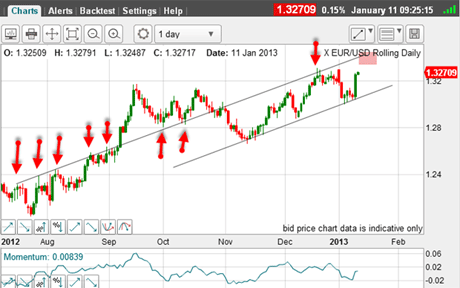
(Click on the chart for a larger version)
And my immediate target was the upper line in the pink zone.
And here is that chart updated to this morning:

(Click on the chart for a larger version)
Overnight, the market reached 1.34, making that a hit, depending on exactly where you place the upper tramline.
But I also have a long-term tramline pair working:

(Click on the chart for a larger version)
This is the daily chart going back to the prior pivot point(PPP) in October/November 2010.
The market has clearly broken above my centre line and is heading towards my upper line in the pink zone.
The Fibonacci 50% retrace level in the 134.50 to 1.35 area lies directly ahead and should provide huge resistance (as it did in late February 2012).
That means progress from here should be a lot more difficult.
The importance of trade timing
These are exciting times in the euro and using my trading methods, good profits are being made.
Trying to figure out the market direction from the economic data is a fool's errand in my view.
For one thing, there is a mountain of relevant data out there, much of which is contradictory hence the acres of newsprint devoted to analysing' it.
And for another, we are dealing with a leveraged product when we spread bet.That makes the timing of trade entries of critical significance.
No fundamental analysis is of any use in this area.
That is why I have developed trade timing to such an exacting degree.
If you're a new reader, or need a reminder about some of the methods I refer to in my trades, then do have a look at my introductory videos:
The essentials of tramline trading
An introduction to Elliott wave theory
Advanced trading with Elliott waves
Don't miss my next trading insight. To receive all my spread betting blog posts by email, as soon as I've written them, just sign up here . If you have any queries regarding MoneyWeek Trader, please contact us here.
Get the latest financial news, insights and expert analysis from our award-winning MoneyWeek team, to help you understand what really matters when it comes to your finances.
John is is a British-born lapsed PhD physicist, who previously worked for Nasa on the Mars exploration team. He is a former commodity trading advisor with the US Commodities Futures Trading Commission, and worked in a boutique futures house in California in the 1980s.
He was a partner in one of the first futures newsletter advisory services, based in Washington DC, specialising in pork bellies and currencies. John is primarily a chart-reading trader, having cut his trading teeth in the days before PCs.
As well as his work in the financial world, he has launched, run and sold several 'real' businesses producing 'real' products.
-
 Review: Eden Roc Cap Cana – fun, sun and golf in the Caribbean
Review: Eden Roc Cap Cana – fun, sun and golf in the CaribbeanTravel Eden Roc Cap Cana in the Dominican Republic offers everything from relaxing by the pool to a world-class golf course
-
 Reeves delays cash ISA reform, but savers are not out of the woods yet
Reeves delays cash ISA reform, but savers are not out of the woods yetThe chancellor has reportedly delayed plans to cut the cash ISA limit, which were set to be announced at Mansion House on 15 July, and will take more time to consult with the industry
-
 The pound could hit parity with the euro – but if it does, buy it
The pound could hit parity with the euro – but if it does, buy itFeatures Anyone visiting the continent this summer will have been in for a rude shock at the cash till, says Dominic Frisby. But the pound won't stay down forever.
-
Gold’s rally should continue
Features Matthew Partridge looks at where the gold price is heading next, and what that means for your online trading.
-
 Prudent trades in Prudential
Prudent trades in PrudentialFeatures John C Burford shows how his trading methods can be used for more than just indices and currencies. They work for large-cap shares too.
-
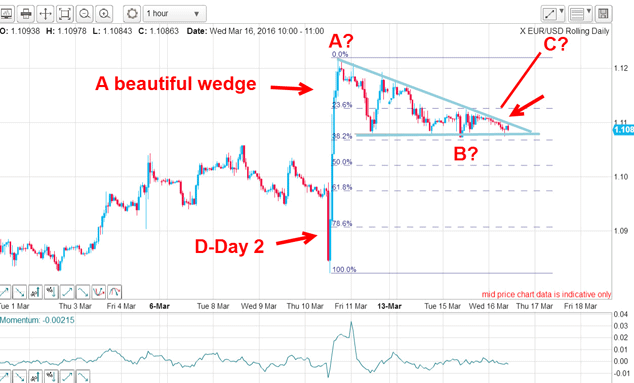 Did you find the path of least resistance in EUR/USD?
Did you find the path of least resistance in EUR/USD?Features John C Burford outlines a trade in the euro vs the dollar in the wake of the US Federal Reserve’s most recent announcement.
-
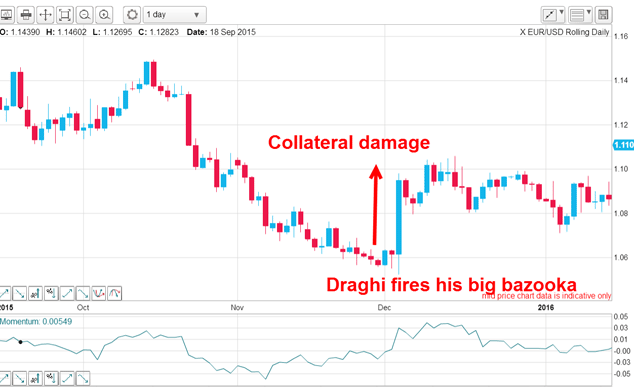 How to find the path of least resistance for EUR/USD
How to find the path of least resistance for EUR/USDFeatures A belief that "news makes the markets" would have lost you a lot of money betting against the euro, says John C Burford. Here's what to watch instead.
-
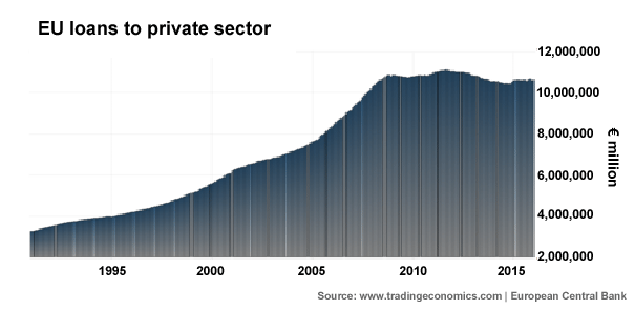 Lightning has struck twice in the euro
Lightning has struck twice in the euroFeatures Mario Draghi's latest stimulus package took the euro market by surprise, says John C Burford. But not chart-following swing traders.
-
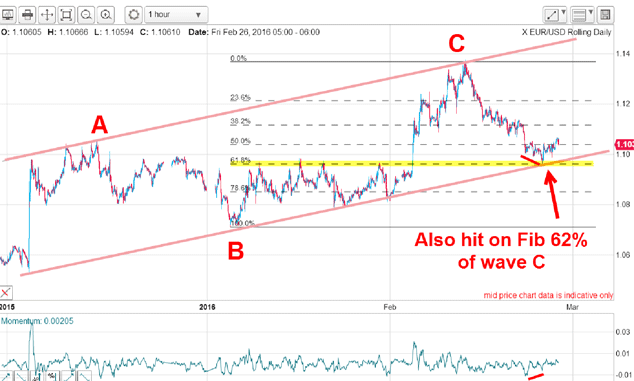 The euro finds support as sentiment plummets
The euro finds support as sentiment plummetsFeatures No need to wait for the European Central Bank announcement on Thursday, says John C Burford. Elliott wave theory tells you all you need to know.
-
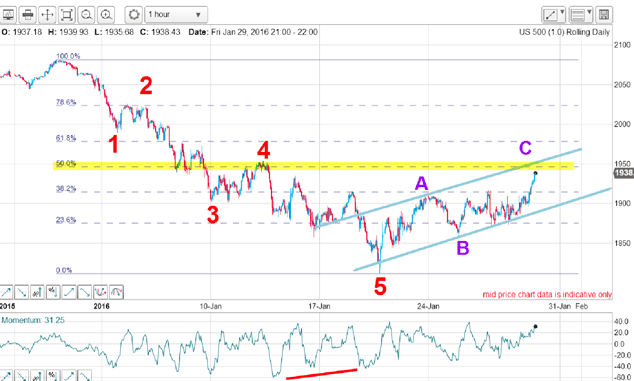 Stockmarkets rally, just as I forecast
Stockmarkets rally, just as I forecastFeatures The sharp rally in stocks caught the pundits by surprise, says John C Burford. But chart-following traders saw it coming.